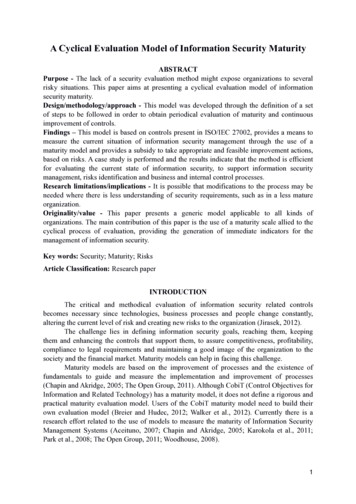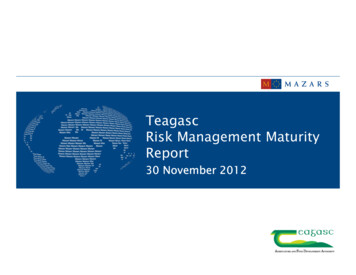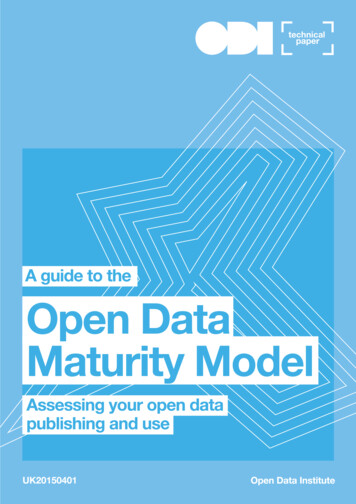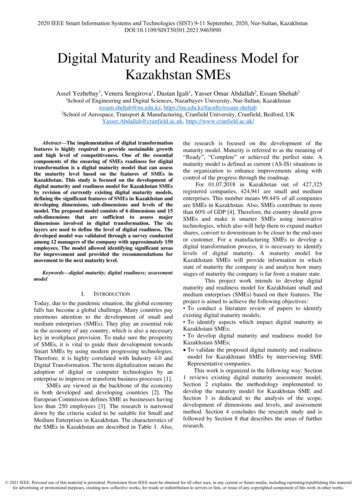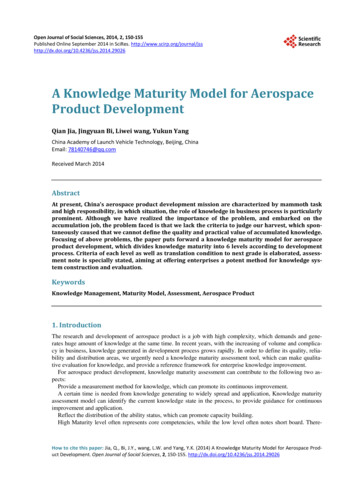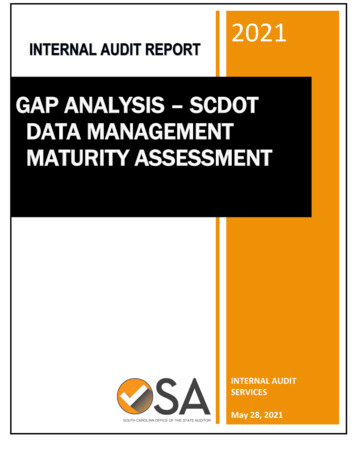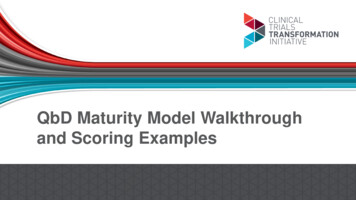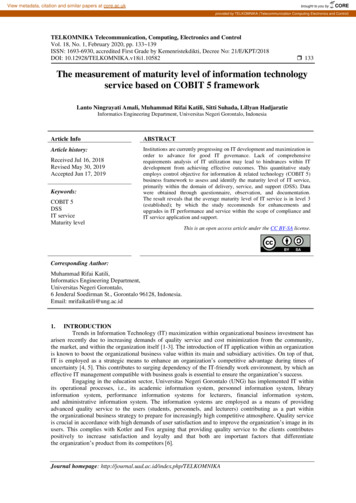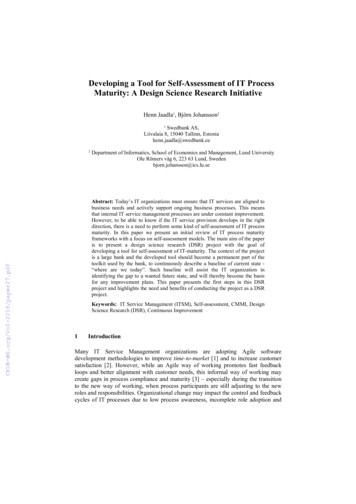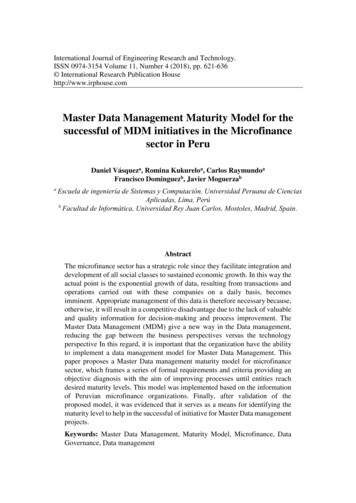
Transcription
International Journal of Engineering Research and Technology.ISSN 0974-3154 Volume 11, Number 4 (2018), pp. 621-636 International Research Publication Househttp://www.irphouse.comMaster Data Management Maturity Model for thesuccessful of MDM initiatives in the Microfinancesector in PeruDaniel Vásqueza, Romina Kukureloa, Carlos RaymundoaFrancisco Dominguezb, Javier MoguerzabaEscuela de ingeniería de Sistemas y Computación. Universidad Peruana de CienciasAplicadas, Lima, PerúbFacultad de Informática, Universidad Rey Juan Carlos, Mostoles, Madrid, Spain.AbstractThe microfinance sector has a strategic role since they facilitate integration anddevelopment of all social classes to sustained economic growth. In this way theactual point is the exponential growth of data, resulting from transactions andoperations carried out with these companies on a daily basis, becomesimminent. Appropriate management of this data is therefore necessary because,otherwise, it will result in a competitive disadvantage due to the lack of valuableand quality information for decision-making and process improvement. TheMaster Data Management (MDM) give a new way in the Data management,reducing the gap between the business perspectives versus the technologyperspective In this regard, it is important that the organization have the abilityto implement a data management model for Master Data Management. Thispaper proposes a Master Data management maturity model for microfinancesector, which frames a series of formal requirements and criteria providing anobjective diagnosis with the aim of improving processes until entities reachdesired maturity levels. This model was implemented based on the informationof Peruvian microfinance organizations. Finally, after validation of theproposed model, it was evidenced that it serves as a means for identifying thematurity level to help in the successful of initiative for Master Data managementprojects.Keywords: Master Data Management, Maturity Model, Microfinance, DataGovernance, Data management
622Daniel Vásquez, et al1 INTRODUCTIONMicrofinance institutions have generated a great impact on growth, Peru having themost favorable environment for financial inclusion worldwide (Microscopio Global,2016). Likewise, microfinance systems experienced a growth of 13.12% in 2016compared to 2015 (Association of Microfinance Institutions, 2016), representing asignificant increase in customers, leading to more daily transactions and a large amountof data to process. Proper master data management is necessary to avoid redundant andinconsistent data, thus avoiding competitive disadvantages before other financialentities. Therefore, there is a need for a model in the microfinance sector whichevaluates master data maturity levels, to take necessary actions in reaching desiredlevels. It is of vital importance to have adequate data management since the averagecost of each lost or stolen record containing sensitive information (such as master datain organizations) is 141, resulting in an average loss of 3.79 million per year(Ponemon Institute and IBM, 2017).Although master data management maturity models exist, they are not in line with themicrofinance sector regulations, criticality and data volume (Computing, 2015).Recently, Marco Spruit and Katharina Piezka proposed a maturity model based on bestpractices, however the same authors state that few models were analyzed, and that moreexperts should be consulted to determine exact dimensions (Spruit and Pietzka, 2015).Oracle also developed a maturity model based on five key areas; however, these areasare more aligned to a technical framework (Oracle, 2013). In 2010, Dataflux clearlyshows components of DMM in a service model, also focusing on the technologicalaspect (Dataflux Company, 2010). In that same year, IMN proposes a maturity modelwith a good basis, especially regarding levels, but with a high-level perspective. Forthis reason, we developed a robust maturity model based on previous model analysis,as well as international regulations and framework, which allows evaluating differentareas of company processes, which we have denominated "Dimensions". We begin withevaluating data policies and management, providing a general context fororganizations, which serves as support for adequate data integration, thus ensuringquality. Finally, the model evaluates monitoring and control of data managementprocesses, in order to determine whether indicators, which measure evolutionprocesses, exist and are adequately managed. The model has 14 criterions specifically,distributed in six dimensions and five levels of maturity based on CMMI, since it canbe easily used in government processes or data management (Stanford University,2011).Our study is divided into 5 sections. Section 2 consists in describing the study andliterature review based on master data management topic or frameworks, and datamanagement maturity models. Section 3 describes steps for designing proposedmaturity model levels and criteria, linking existing models, and comparing tables.Additionally, this section describes model evaluation processes. Section 4 describesmodel validation results from being applied in a case study. Finally, section 5 detailsresearch conclusions and results obtained from model application.
Master Data Management Maturity Model for the successful of MDM initiatives 6232 RELATED WORKWe decided on four approaches based on research and literature review: DataManagement Maturity Models, Guidelines for Master Data Management, AppliedRegulations in Master Data Management and Master Data Management MaturityModels.Despite large numbers of maturity models related to data management, the most recentpublished contributions have been taken into consideration. In 2017, Rivera, Loarte andRaymundo focused on the microfinance sector and proposed a data managementmaturity model contemplating a series of requirements and criteria related toinformation security, data quality, principles, among others. Criteria must be fulfilledso organizations in this sector obtain objective diagnoses. Moreover, it is necessary topoint out the works of Marco Spruit and Catalina Sacu, published in 2015, who studiedcomplexities in realizing Data Warehouse projects, concluding the importance of a DataWarehouse maturity model to measure project management and progress. In 2016,Marco Comuzzi and AnitPatel implemented a maturity model focusing on Big Data,supporting its necessity due to poor technological management, taking organizational,technological and strategic aspects into account. The same year, Pedro Domingues,Paulo Sampaio, and Pedro M. Arezes presented the first attempt to standardizeintegrated management systems, which in turn allows comparing and evaluatingintegrated systems in different organizations through a maturity model, allowingorganizations to evaluate integrated management systems and thus plan activities toavoid unnecessary resource wastes. Ampuero, Alfaro, Raymundo and Dominguezperceive positive changes in organizations with respect to data value, and in 2013 theydesigned a techno-organizational data management maturity model, based on 11categories, which allowed organizations to ensure success in their initiatives anddiscipline.In 2012, Boris Otto carried out a case study on master data architecture design andmaintenance, applied in the Bosch organization, based on four approaches toarchitecture: analytical, transactional, coexistent and parallel, showing four ways todistribute and relate master data sources with local systems owned by businesses (Otto,2012). Martin Hubert and other authors describe a reference model with an integralview of the life cycle of master data, including strategic, operational and tacticalaspects, to provide more comprehensive support for analysis (Hubert, 2013). In anempirical study carried out the same year, Anders Haug managed to identify 12 barriers,which generate poor quality in master data management and frequency according tocompany size (Haug et al., 2013). In the same way, Dominic Gerardi emphasizes theimportance of master data quality by conducting research oriented to the health sector,explaining the need to have specific responsibilities for maintaining master data, andthat not properly managing relationships between data quality and master data willincrease costs and complexities (Gerardi, 2017). Following the importance of dataquality, studies by Bibiano Rivas used ISO 80001x0 clauses to develop service design
624Daniel Vásquez, et alfor the exchange of master data among organizations, thus developing a data dictionarywith master data terms; a communication protocol; an API to manage master datamessages; and algorithms to measure data quality. Unlike previous studies, RikkaVilminko not only identifies aspects related to quality, but also obstacles and problems,which organizations may encounter when developing a master data managementinitiative. The study identified 15 obstacles, which help understand key aspects ofmaster data management in an organization (Vilminko, 2017). All contributionspresented are useful to knowing what areas to take into consideration when designinga model or implementing a master data management solution in an organization.In the financial sector, it is essential to show reliability both in daily transactions and inreports presented. In 2012, Ya. R. Nedumov mentioned that the biggest complicationwhen managing master data is ensuring integrity, coherence and consistency. Thecontribution it provides is based on standardization techniques of regulatory referenceinformation, which make it possible to fix data, identify duplicates and unifyredundancies. On the other hand, in 2014, László Szívós considers that the means toachieving transparent presentations of financial statements focuses on the veracity andaccuracy of master data and master files for proper presentation. This belief is reflectedin his research, where he analyzes control procedures of data sources used by financialinstitution and introducing the indispensable task of an auditor. In summary, bothinvestigations address aspects, which support achieving adequate master datamanagement from a regulatory perspective.Finally, the most recent Master Data Management Maturity Models were analyzed. In2010, Sanjay Kumar mentioned that master data management program success wasunlikely, so he proposed a model with six maturity levels, where each level includedsystems and actions that should be taken to reach the next level (Sanjay Kumar, 2010).That same year, Dataflux presented a maturity model divided into six layers, containingcomponents related to technical, operational and administrative aspects in each. In thisway, each component has capacities that will be increased based on maturity levels inwhich organizations are located (Dataflux, 2010). In 2013, Oracle proposed five keyareas to evaluate the entire organization. Likewise, it made use of levels defined byCMMI, to ensure the correct evaluation by entities (Oracle, 2013). The most recent andwell-known model for managing master data is MD3M, which has thirteen areas andsixty-five capabilities. It also provides a more specific approach to criteria consideredby each process area.Each presented model has different areas, criteria and levels to be evaluated, howeverall maturity models described have the same purpose, to determine master datamanagement maturity levels.
Master Data Management Maturity Model for the successful of MDM initiatives 6253 MASTER DATA MANAGEMENT MATURITY MODEL3.1 BasesIn order to define proposed model components, an analysis was made of six maturitymodels used in leading market organizations with high impact, providing a solidknowledge base, considering necessary aspects for evaluation of master datamanagement in organizations. We have denominated these aspects dimensions. Eachmodel has its own definition for dimensions; however, we have grouped those, whichwill be used, for our model. Policies: It is important to have policies in order to have an atmosphere ofknowledge (Spruit and Pietzka, 2015). Data controls, security norms andpolicies must be established (Oracle, 2013). In an MDM initiative, stakeholdersmust adhere to organization policies (Dataflux Company, 2010). Data policies,standards and best practices should be developed, audited and applied (StanfordUniversity, 2011). Organizations must have policies and procedures (ECM,2009). Data Governance: Data governance imposes business policies for data standardswithin an MDM environment (Dataflux Company, 2010). Data management istransversally associated with business units (SanjayKumar, 2010). Maturitymodels are linked to data governance (Stanford University, 2011). Data Model: This is a key issue that deals with data and infrastructure (Spruitand Pietzka, 2015). Data models (Data flux Company, 2010) represent MDMdesigns. Data Integration: Systematic data integration is crucial for business (Spruit andPietzka, 2015). Master data solutions should be used in data integrationsbetween applications (Oracle, 2013). The reality of MDM is the integration ofdata (Dataflux Company, 2010). Data Quality: This aspect includes evaluation techniques (Spruit and Pietzka,2015). Data quality is important (Oracle, 2013). Data quality affects MDM(Dataflux Company, 2010). Master data management must be synchronizedwith data quality (SanjayKumar, 2010). Parameters should be defined foracceptable data quality levels (Stanford University, 2011). Monitoring: Proactive monitoring for data quality control is crucial (DatafluxCompany, 2010). Processes must provide feedback and monitoring (ECM,2009).
Daniel Vásquez, et al626Table 1: Dimension Comparison MatrixMODELSMD3M (Spruitand Pietzka, 2015)Oracle (Oracle,2013)DataFlux(DatafluxCompany, 2010)IMN (SanjayKumar, 2010)DG (StandfordUniversity, 2011)ECM3 (ECM,2009)DIMENSIONESPoliticsDataDataDataData Monitoringmanagement models integration qualityXXXXXXXXXXXXXXXXXXXXMaturity models analyzed present different levels of maturity, with which organizationsare properly categorized according to dimensions. In table 2, it can be seen that mostmodels adopt CMMI levels, which pose five maturity levels. Initial: AdHoc or Chaotic processes, providing an unstable environment (IBM,2007) (Stanford University, 2011). A first awareness has been raised toproblems related to MDM at the operational level (Spruit and Pietzka, 2015).Managed: Process approach to projects and is often reactive (IBM, 2007).Individual measurements are carried out to solve individual problems. There isno connection with other units or projects. Operative (Spruit and Pietzka, 2015).Defined: Process characterized by organization and is often Proactive (IBM,2007). The first collaborations take place at a tactical level (Stanford University,2011). Awareness was created to encourage other initiatives (Spruit and Pietzka,2015).Quantitatively Managed: Measured and Controlled Process (IBM, 2007). Bestpractices for MDM. (Spruit and Pietzka, 2015). Processes are defined at thetactical level (Stanford University, 2011).Optimized: Optimized MDM. Improved company efficiency. Tactical approachon the subject (Standford University, 2011).After analyzing maturity model levels, we realized that CMMI has been usedsuccessfully in master data management models as well as data governance, due to easyadaptability.
Master Data Management Maturity Model for the successful of MDM initiatives 627Table 2: Level Comparison MatrixMODELSNIVELES DE MADUREZ1234Initial Repeatable DefinedManaged tialReactive ManagedProactiveMD3M (Spruitand Pietzka, 2015)Oracle (Oracle,2013)DataFlux(DatafluxCompany, 2010)IMN (SanjayInitialIsolatedKumar, 2010)DG StanfordInitialManaged(StanfordUniversity, 2011)ECM3 ationalProactive3.2 ModelWe observed that models recur in some areas or dimensions, based on analysis carriedout in point A, also emphasizing the importance of evaluating not only issues related tomaster data management, but also issues related to policies, data Governance, amongothers. For this reason, the proposed model consists of 6 dimensions and 14 evaluationcriteria.Figure 1: Graphic representation of the MDM Maturity Model aligned to theMicrofinance Sector
Daniel Vásquez, et al6283.2.1Dimensions and CriteriaAfter comparing maturity models analyzed in point A, the following dimensions wereidentified, closely aligned with realities and needs of microfinance institutions in Peru. Policies: Microfinance institutions comply with different internationalregulations, which allow for an across-the-board evaluation throughout theorganization, which is why we have considered it a key pillar in evaluating theextent to which policies are defined, formalized and implemented in terms ofdata management in those entities.Criteria making up this dimension are:o Policies, procedures and methodsData Governance: Definition of this domain involves evaluating roles andresponsibilities defined in the organization, as well as data use and ownership.Criteria making up this dimension are: oRoles and responsibilitiesoUse and ownershipData Model: This domain is in charge of evaluating to what extent master datain the organization has been identified. It is also responsible for measuringmaster data models to serve as general data descriptions. Criteria making up thisdimension are:oMaster data identificationoMaster data dictionaryoLandscape dataData Integration: This domain forms the central part of the model. It isresponsible for identifying the extent to which controls are applied to dataprocessing, combining them from different sources to manage extraction,transformation and loading mechanisms, considering business rules and legalrequirements. In addition, this domain ensures alignment between businessesand IT, to subsequently implement data integration designs.Criteria making up this dimension are: oMaster data integrationoMaster data alignmentoData integration designsData Quality: This domain covers data life cycles. Starting by identifyingorganization quality barriers, followed by evaluation of data quality andimprovement.Criteria making up this dimension are:oMaster data life cycle
Master Data Management Maturity Model for the successful of MDM initiatives oIdentification of quality barriersoQuality evaluationoImprovements in quality629Monitoring: The purpose of this dimension is to identify to what extent masterdata management performance is monitored transversally in organizations, inorder to measure and identify potential data problems.Criteria making up this dimension are:oMonitoring and ReportsBelow is a table with evaluation criteria associated to each dimension in evaluatingorganizations.Table 3: Model Evaluation CriteriaDimensionCriteriaPoliticsPolicies, procedures and Methods. (Spruit and Pietzka, 2015) (Oracle, 2013)(Dataflux Company, 2010) (SanjayKumar, 2010) (Stanford University, 2011)(ECM, 2009)DatagovernanceRoles and responsibilities (Dataflux Company, 2010) (SanjayKumar, 2010)Use and ownershipUniversity, 2011)(Spruit and Pietzka, 2015) (Oracle, 2013) (StanfordData models Master data identification (Spruit and Pietzka, 2015) (Dataflux Company, 2010)(Stanford University, 2011)Master data models (Spruit and Pietzka, 2015)Landscape data (Spruit and Pietzka, 2015)DataintegrationMaster data integration (Dataflux Company, 2010)Data alignment (Spruit and Pietzka, 2015)Data integration designs (Spruit and Pietzka, 2015)Data quality Master data life cycles (Spruit and Pietzka, 2015) (Oracle, 2013) (DatafluxCompany, 2010)Identification of quality barriers (Spruit and Pietzka, 2015)Quality evaluation (Spruit and Pietzka, 2015) (Dataflux Company, 2010)Quality improvements (Spruit and Pietzka, 2015)MonitoringMonitoring and reports (Dataflux Company, 2010) (ECM, 2009)
Daniel Vásquez, et al6303.2.2Maturity levelsBased on analysis carried out in point A, we concluded that CMMI is easily adapted todata management models. This scheme was adapted to Master Data Management andmicrofinance needs. The following figure shows the established levels of the model,which helps identify maturity levels of organizations in terms of criteria evaluated:Figure 2: Evaluation Tool Questionnaire3.2.3QuestionnaireThe questionnaire was developed under international standards, which provideinformation on proper master data management. In addition, three components in theStanford Data Governance model were used in order to clearly identify differencesbetween levels; therefore, each evaluation criterion must approve these threecomponents in order to reach the next maturity level. 3.2.4Policies: This component ensures that evaluation criteria is measured based ondocumentation, formalization and definitions of processes and policies relatedto data management.People: This component ensures that evaluated criteria measures if roles andresponsibilities have been defined. It also assesses awareness levels of people.Capacities: This component measures capacities of organizationsEvaluation ToolA tool was implemented on a WEB platform in order to count on a consistent, easy-touse evaluation tool. This platform can be accessed by microfinance entities previously
Master Data Management Maturity Model for the successful of MDM initiatives 631registered in the database, so that they can submit the questionnaire and obtain resultsbased on the status of their entity with respect to dimensions presented in the previoussection. Main features of the tool can be seen in the following and referringto Figure 2:1-One user per microfinance institution2-The platform provides principal data regarding the model.3-The questionnaire is found on the platform, allowing the user to save their progressand re-enter the platform to complete the questionnaire whenever they wish.4-The platform shows evaluation results through a radial graph.5-The tool compares microfinance institution results with the average result of allrelated entities having completed the survey.Having answered the questions in the questionnaire, microfinance institutions will beable to visualize results according to previously presented dimensions and criteria, andtheir scores.At the Model levelScoremodel dd 1ScoreDimensionD(1)At the dimension levelScoredimension crcr 1Scorecriteriacr(2)At criteria levelcScorecriteria pc nc 1D number of dimensionscr Number of criteriac Number of componentspc Importance of componentn Maturity level(3)
Daniel Vásquez, et al632The following table shows score intervals that organizations must obtain to becategorized in a maturity level.Table 4: Obtained score representationScoreMaturity level0 Score 1Initial1 Score 2Managed2 Score 3Defined3 Score 4Quantitatively managed4 Score 5Optimized4 VALIDATIONIt is very important to establish a degree of confidence in the model to guarantee its useand application. For this reason, a validation process was implemented based on thefollowing points:4.1 PlanningThe validation scope was defined in the first stage, starting with microfinanceinstitution selection and selection of necessary requirements to carry out the study andvalidate the maturity model. We considered evaluating all model dimensions presented,with their corresponding evaluation criteria, in order to achieve complete validation.The entity was given the pseudonym Microfinancing Company DVK for confidentialityand information protection issues. Microfinancing company DVK is a leading entity inthe Peruvian microfinance sector, and its mission is to provide support to families withlimited economic resources but with desires to improve their quality of life throughdifferent financial products. This entity is one of the few microfinance institutions thathave a presence in all regions of Peru, with close to 500,000 clients, 2,000 employeesand approximately 140 offices nationwide. Finally, to complete the planning stage, itwas necessary to select those professionals who had experience in the microfinancesector and knowledge in master data management as well as international regulations.4.2 Model application and diagnosisThe next step was based on evaluation of maturity model application to Microfinancingcompany DVK through the questionnaire. Once the questionnaire was completed,diagnoses were obtained, determining maturity levels in terms of dimensions andcriteria defined, and represented in a matrix, which allowed distinction of resultsachieved (Table 4). These results were calculated based on formulas presented in theprevious section.
Master Data Management Maturity Model for the successful of MDM initiatives 633Table 5: Level Comparison Matrix4.3 ResultsAnalysis of results is the last step in completing validation. Diagnoses obtained in theprevious stage were analyzed in order to provide plans of action to improve maturitylevels. In Figure 4, microfinancing company DVK showed a score of 4 out of 5 in thePolicy dimension, being the most outstanding dimension of all, supervised constantlyand even more so in the technological aspect, to corroborate information obtained incritical reports, through policy definition and formalization. Dimensions whichobtained the lowest score were Data Quality, Monitoring and Data Models, reachinglevel two (Managed). This means that the microfinancing company DVK has identifiedconcepts and requirements they need to carry out good master data managementpractices, however, they have not yet implemented most criteria. In addition, DataIntegration was at a level 3 (Defined), which means that not only have the business
Daniel Vásquez, et al634rules and master data integration processes been defined, but a master data managementsolution has also been implemented to ensure the continuity of unique records based onan integration designs. Finally, the score achieved in Data governance is because theorganization not only knows the need for definition of roles and responsibility, andusing appropriate data, but also promotes other areas to use data properly in dailyfunctions. The organization obtained an average score of 2.45, which translates intolevel three (Defined). Based on this fact, plans of action were outlined, in a summarizedmanner, to reach the next maturity level. First, organizations must implement datamanagement policies. Second, they must establish roles and responsibilities, as well asinstill awareness regarding data use and ownership. Next, organizations must identifythe master data of each unit, define data models and implement master data integrationprocesses. Finally, organizations must establish indicators for monitoring implementedprocesses.Figure 4: Radial graph representation of diagnosis5 CONCLUSIONSIn this paper, a master data management maturity model was proposed for amicrofinance sector in Peru, based on strict literature review, other similar models, aswell as frameworks and international standards. The model includes closely related andcoherent dimensions to perform a comprehensive analysis of organizations,consolidated with evaluation criteria in line with microfinance sectors. We also offeran online assessment tool where entities can access and complete a questionnaire usedto subsequently obtain a corresponding diagnosis and their maturity levels.The model was validated for a Peruvian microfinance institution, which madesatisfactory use of the model evaluation tool, obtaining results through a radial chartand a detailed chart (Figure 3). Unlike other existing maturity models, our tool providesrecommendations for entities to reach desired maturity levels in a later evaluation, whilevisualizing their progress and improvement in the maturity level obtained.
Master Data Management Maturity Model for the successful of MDM initiatives 635ACKNOWLEDGEMENTSWe thank the Peruvian University of Applied Sciences for partially financing this workand the opportunities offered to successfully complete the project.REFERENCES[1]Spruit, M. and Sacu, C. (2015). DWCMM: The Data Warehouse CapabilityMaturity Model. Journal of Universal Computer Science, 21(11),1508–34. doi:10.3217/jucs-021-11-1508[2]Spruit, M. and Pietzka, K. (2015). MD3M: The Master Data ManagementMaturity Model.Computers in Human Behavior, 51, 1068-76. doi:10.1016/j.chb.2014.09.030[3]Oracle (2013). MDM Maturity Model. Retrieved July1, 2017 ataFlux Company (2010). MDM Components and the Maturity pdf[5]The Economist Intelligence Unit Limited(2015). Microscopio Global 2015:Análisis del Entorno para la Inclusión Financiera. Retrieved May ent.aspx?DOCNUM 40024155[6]Asociación de Instituciones de Microfinanzas. (2016). Sistema MicrofinancieroPerú. Retrieved Abril 12, 2017 from http://www.asomifperu.com/web/[7]Ponemon Institute(2017)Cost of Data Breach Study. Retrieved June 15, sialias?htmlfid SEL03130WWEN[8]Comuzzi, M. and Patel, A. (2016) How Organisations Leverage Big Data: AMaturity Model. Industrial Management & Data Systems, 116.8, 1468.-92. doi:10.1108/IMDS-12-2015-0495[9]Domingues, P. and Sampaio, P. and Arezes, P. (2016). Integrated ManagementSystems Assessment: A Maturity Model Proposal. Journal of CleanerProduction, 124, 164-74. doi: 10.1016/j.jclepro.2016.02.103[10] Otto B. (2012). How to Design the Master Data Architecture: Findings from aCase Study at Bosch. International Journal of Information Management, 32.4,337-46. doi: 10.1016/j.ijinfomgt.2011.11.018[11] Hubert, M. and Straub, K. and Otto, B. (2013) Management of the Master Da
Master Data Management, Maturity Model, Microfinance, Data Governance, Data management . 622 Daniel Vásquez, et al . 1. INTRODUCTION . Microfinance institutions have generated a great impact on growth, Peru having the most favorable environment for financial inclusion worldwide (Microscopio Global,
